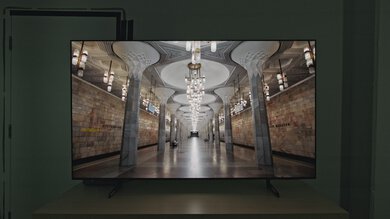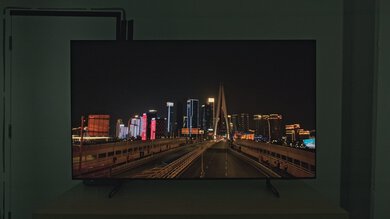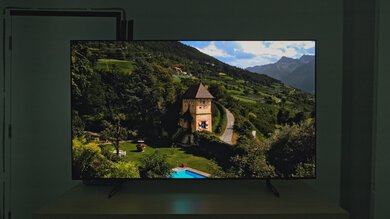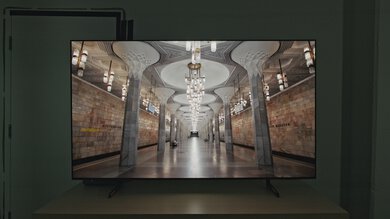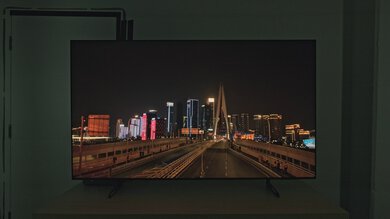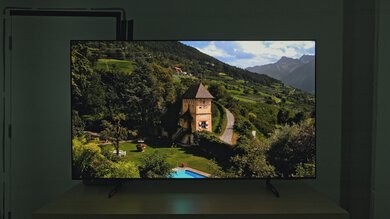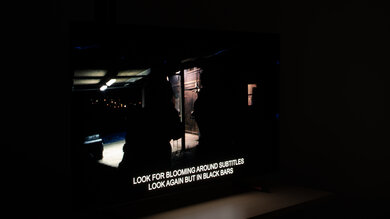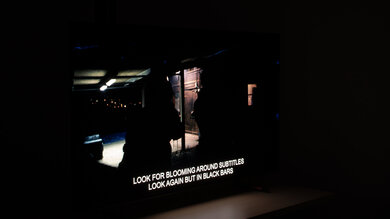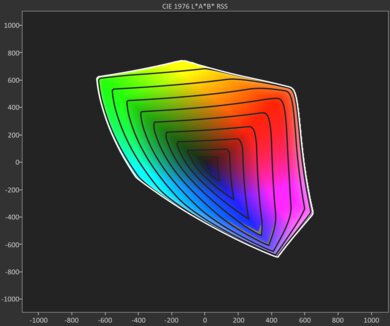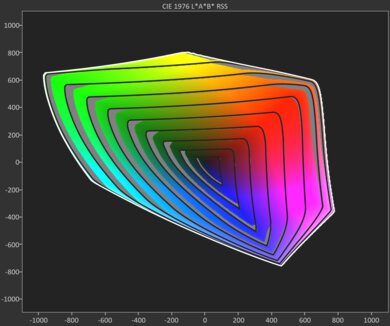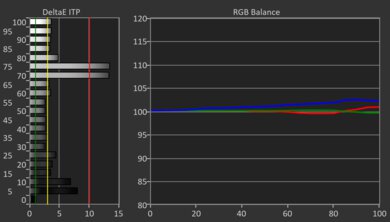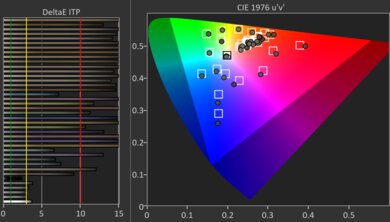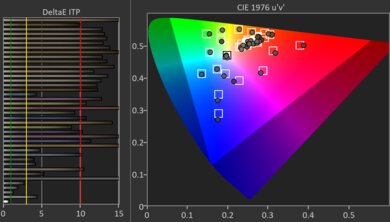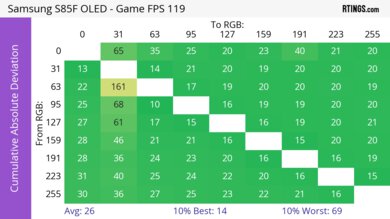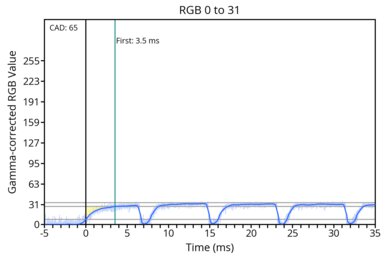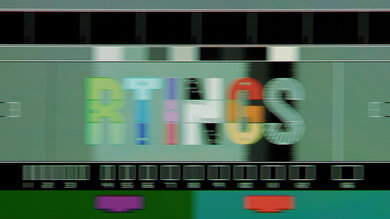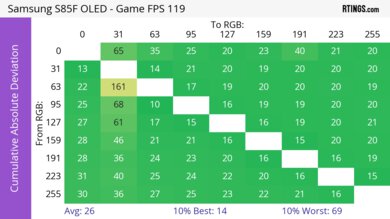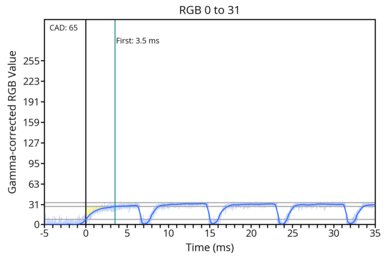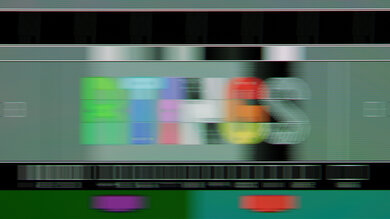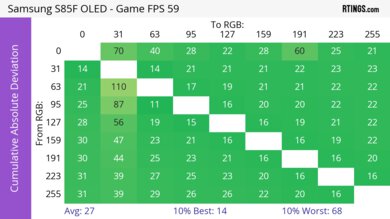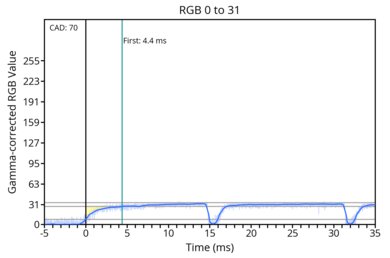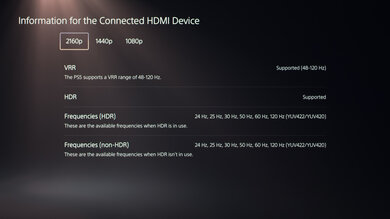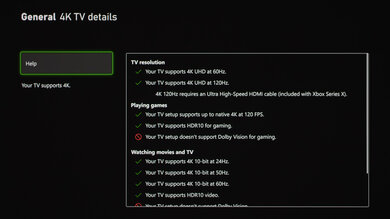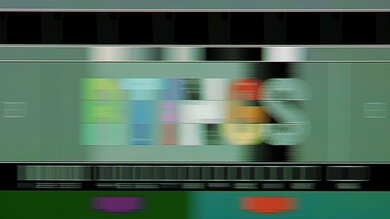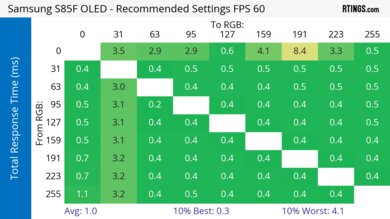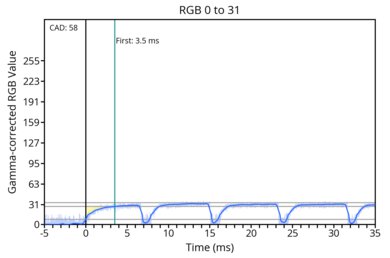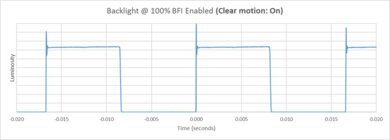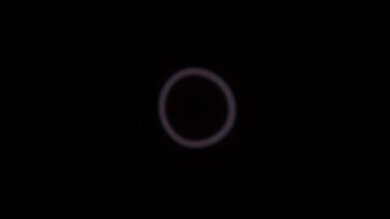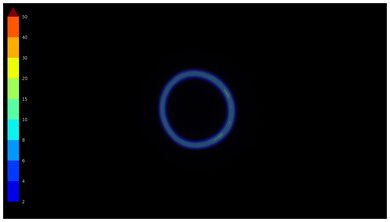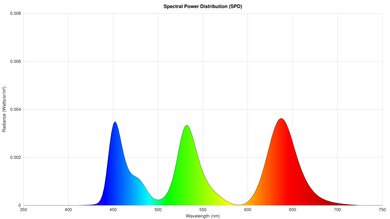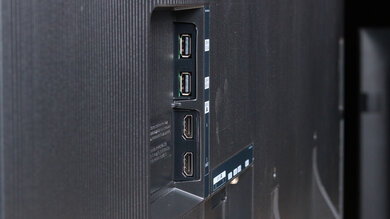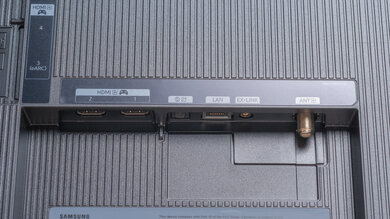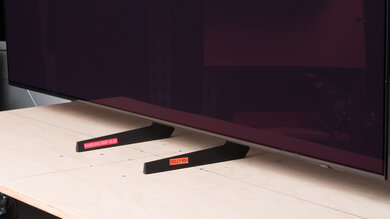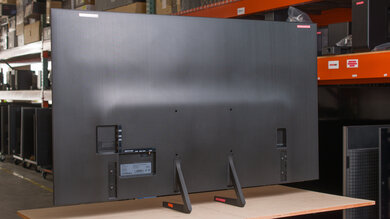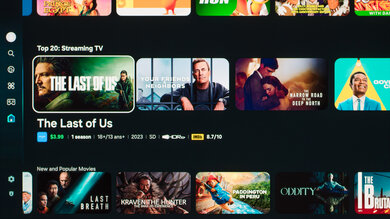The Samsung S85F OLED is Samsung's entry-level OLED in 2025 and replaces the 2024 Samsung S85D OLED. Unlike its predecessor, the TV uses a more colorful QD-OLED panel in its 55 and 65-inch size options. It sits below the Samsung S90F OLED and Samsung S95F OLED. Unlike those higher-end offerings, the S85F uses the older NQ4 AI Gen2 Processor. You still get the 2025 version of Samsung's Tizen OS, which has smart features like voice control and a web browser, and it's cast-capable. It has HDMI 2.1 bandwidth on all four ports, and supports 4k @ 120Hz with VRR. Like all Samsung TVs, it doesn't support the popular Dolby Vision HDR format, but it does support the similar HDR10+. We bought and tested the 65-inch model, and it's available in four different sizes: 55-inch, 65-inch, 77-inch, and 83-inch. Unfortunately, only the 55 and 65-inch models use QD-OLED panels in North America, and the larger sizes both have WOLED panels. Outside of North America, all sizes use WOLED panels.
Our Verdict
The Samsung S85F is a great TV for mixed usage. It's impressive in a dark room due to its perfect black levels, incredibly vivid colors, and adequate HDR brightness. Despite only having okay SDR brightness, it also handles glare pretty well in a room with the lights on, thanks to its solid reflection handling, although blacks do look gray in a room with ambient lighting. The TV is loaded with modern gaming features and has the nearly instantaneous response time OLEDs are known for, so it's a good option to pair with modern consoles. It also has an incredibly wide viewing angle, so it's a solid choice if you watch content with big groups of friends.
Near-infinite contrast ratio for perfect blacks with no blooming around bright highlights.
Incredibly wide viewing angle for a consistent image from the sides.
Colors are incredibly vivid and accurate.
Great handling of direct and indirect reflections.
Black levels are drastically raised in rooms with the lights on.
Only okay SDR brightness means it struggles to overcome glare in very bright rooms.
Isn't bright enough in HDR to display large, bright highlights.
The Samsung S85F is impressive for a home theater. It looks awesome in a dark room thanks to its perfect, inky blacks and incredibly vibrant and accurate colors. It's not a super bright TV in HDR, but its HDR brightness is adequate enough for most highlights to stand out in HDR movies and shows. Furthermore, the brightness of HDR content is remarkably accurate, so this is a TV that respects the filmmaker's intent. It also delivers very good upscaling, so low-resolution content isn't too soft. Although the TV's low-quality content smoothing does a decent job cleaning up artifacts in low bitrate content, it doesn't remove them entirely. Like all OLEDS, the TV's nearly instantaneous response time leads to some stutter in 24fps content, so slower camera movements aren't as smooth as they should be.
Near-infinite contrast ratio for perfect blacks with no blooming around bright highlights.
Colors are incredibly vivid and accurate.
Does a very good job upscaling low-resolution content.
Remarkable HDR brightness accuracy.
No Dolby Vision or DTS audio support.
Noticeable stutter due to the TV's fast response time.
Isn't bright enough in HDR to display large, bright highlights.
The Samsung S85F is decent for a bright room. It's bright enough in SDR to overcome glare in a moderately lit room, but it's not quite bright enough to use in a well-lit room. Fortunately, it does a great job reducing the intensity of direct reflections, like a lamp or window that's opposite the screen. Dark colors lose some noticeable saturation in a room with ambient lighting, but you still enjoy a colorful viewing experience with your lights on. Unfortunately, blacks look gray when you watch TV in a bright environment, and you lose the visual impact this OLED has in a dark room.
Colors are incredibly vivid and accurate.
Great handling of direct and indirect reflections.
Black levels are drastically raised in rooms with the lights on.
Only okay SDR brightness means it struggles to overcome glare in very bright rooms.
The Samsung S85F is good for watching sports. It's bright enough in SDR to handle some glare in a well-lit room, but it's best suited for a moderately lit room. The TV does a very good job upscaling cable broadcasts and streams that aren't in 4k, but it doesn't completely remove artifacts from low bitrate feeds. Colors are vivid and accurate, so your team's jersey pops and looks the way it should. Finally, it's a great choice for hosting big game day parties, since the image doesn't degrade when viewed from the sides of the screen.
Incredibly wide viewing angle for a consistent image from the sides.
Colors are incredibly vivid and accurate.
Does a very good job upscaling low-resolution content.
Great handling of direct and indirect reflections.
Only okay SDR brightness means it struggles to overcome glare in very bright rooms.
The Samsung S85F is excellent for gaming. It has HDMI 2.1 bandwidth, 4k @ 120Hz, and VRR, making it a great pairing with your modern console. It also has low input lag for a snappy gaming experience, and its nearly instantaneous pixel transitions mean fast motion is crystal clear. The TV displays inky, perfect blacks and vivid colors in both SDR and HDR, so you get an image that truly impresses. Although it's not super bright in HDR, its brightness is still adequate, so highlights in HDR games stand out well enough for an impactful experience.
Nearly instantaneous pixel transitions for no noticeable blur behind fast motion.
Colors are incredibly vivid and accurate.
Very low input lag at 120Hz for a responsive experience.
Isn't bright enough in HDR to display large, bright highlights.
The Samsung S85F has okay brightness overall. The TV is bright enough to help fight glare in a room with some lights turned on, but it's not quite bright enough for very bright rooms. Its HDR brightness is adequate, as it's bright enough in HDR for an impactful viewing experience.
Only okay SDR brightness means it struggles to overcome glare in very bright rooms.
Isn't bright enough in HDR to display large, bright highlights.
The Samsung S85F is an OLED, so it has perfect black levels. Blacks are inky in a dark room with no blooming around highlights.
Near-infinite contrast ratio for perfect blacks with no blooming around bright highlights.
The Samsung S85F has amazing colors overall. It has outstanding SDR color volume and excellent HDR color volume, so you get a vibrant viewing experience regardless of the type of content you're watching. It also has excellent SDR color accuracy and good HDR color accuracy out-of-the-box, so it doesn't require calibration if you want colors to appear close to the way they are supposed to.
Colors are incredibly vivid and accurate.
Note: We're in the process of improving our tests related to image processing, but this score should give you a general idea of how a TV performs overall with its image processing capabilities.
The Samsung S85F has great processing overall. The TV does a very good job of upscaling low-resolution content. On the other hand, it only does a decent job smoothing out artifacts in heavily compressed content, so you still see artifacts like macro-blocking. It has outstanding gradient handling, with almost no visible banding in color gradients. Finally, the TV has remarkable PQ EOTF tracking, so it stays true to the filmmaker's intent when it comes to HDR brightness accuracy.
Does a very good job upscaling low-resolution content.
Remarkable HDR brightness accuracy.
Almost no banding at all in color gradients.
The Samsung S85F has fantastic responsiveness while in Game Mode. It has support for G-SYNC, FreeSync, and HDMI Forum VRR, so you get all three of the most common forms of VRR for a nearly tear-free experience. Thanks to its nearly instantaneous pixel transitions, fast motion is very clear. You also get low input lag, especially at 120Hz, so gaming feels responsive.
Nearly instantaneous pixel transitions for no noticeable blur behind fast motion.
Very low input lag at 120Hz for a responsive experience.
We're in the process of fixing the way we evaluate a TV's overall motion handling. This section is currently broken, and the score isn't indicative of how well a TV handles motion overall.
Performance Usages
Changelog
- Updated Jul 30, 2025:
Added a note to the PQ EOTF Tracking section about Samsung's removal of HGIG.
- Updated Jul 25, 2025:
We mentioned the newly reviewed LG B5 OLED in the HDR Pre-Calibration Color Accuracy section of this review.
- Updated Jun 02, 2025:
We mentioned the newly reviewed Samsung S90F OLED in the SDR Brightness section of this review.
- Updated May 13, 2025:
We bought and tested the Samsung S95D OLED and added a mention in the HDR Brightness section.
Check Price
Differences Between Sizes And Variants
We bought and tested the 65-inch QD-OLED Samsung S85F, and these results are also valid for the 55-inch model. It's also available in 77 and 83-inch options, but those use WOLED panels, so they perform differently. Whether or not you get a QD-OLED panel could differ depending on the retailer as well, so pay attention to the model code. If the last four digits end in FXZA, the TV should have a QD-OLED panel, but if the code ends in EXZA, it likely has a WOLED panel. Outside of North America, all TV sizes use a WOLED panel, and our results aren't valid for those.
The TV is also sold as the Samsung S85FD at warehouse stores like Costco and Sam's Club, and comes with a longer warranty. These variants perform the same, but just like the normal 77-inch version, the 77-inch variant is a WOLED.
| Size | US Model | Canada Model | Warehouse Model | Display Technology |
|---|---|---|---|---|
| 55" | QN55S85FAFXZA | QN55S85FAFXZC | N/A | QD-OLED |
| 65" | QN65S85FAFXZA | QN65S85FAFXZC | QN65S85FDFXZA | QD-OLED |
| 77" | QN77S85FAEXZA | QN77S85FAEXZC | QN77S85FDEXZA | WOLED |
| 83" | QN83S85FAEXZA | QN83S85FAEXZC | N/A | WOLED |
Our unit was manufactured in March 2025.
Popular TV Comparisons
The Samsung S85F is a bit of a peculiar TV. It's comparable to a TV like the LG B4 OLED, but its QD-OLED panel delivers top-notch color performance. Unfortunately, only the 55 and 65-inch models use a QD-OLED panel, so you don't get the same color performance on the larger sizes or if you're not in North America. Outside of brightness, it performs similarly to the 2024 Samsung S90D OLED, but is limited to 120Hz. The S90D is still better overall, and if you can find it for around the same price as the S85F, it's still the better choice. If you want something bigger and are okay with a WOLED panel, the LG B4 OLED is the better option, since it supports Dolby Vision and has better overall image processing.
For more options, check out our recommendations for the best OLED TVs, the best gaming TVs, and the best 70-75-77 Inch TVs.
The Samsung S90D OLED (QD-OLED version) is better than the Samsung S85F OLED (QD-OLED version). Although the TVs are similar overall, the S90D is much brighter in HDR, so highlights pop out more to the viewer, and it delivers a more complete HDR experience. The S90D also supports 144Hz, which is great for PC gamers.
The Samsung S90F OLED is better than the Samsung S85F OLED. The S90F offers a much more immersive viewing experience due to its far brighter HDR highlights and better HDR color volume, while also being brighter in SDR. Plus, the S90F is the better option for PC gamers due to its 4k @ 144Hz support, while the S85F is limited to 4k @ 120Hz.
The LG C4 OLED and the Samsung S85F OLED (QD-OLED version) are both great TVs with different strengths. The Samsung displays a wider range of colors, so it delivers more vibrant colors. On the other hand, the LG gets brighter in HDR, so highlights stand out more on it. The LG also has better image processing, and it supports 144Hz, Dolby Vision, and DTS audio passthrough, making it more versatile.
The Samsung S85F OLED (QD-OLED) is a solid upgrade when compared to its predecessor, the Samsung S85D OLED. The biggest difference is that the S85F has a huge advantage in overall color performance. The S85F is also brighter in HDR, so highlights pop out a bit more on it, and it does a better job handling direct reflections. On the other hand, the S85D does a much better job of maintaining its black levels in a bright room, whereas blacks look gray on the S85F in a room with ambient lighting.
Test Results

The Samsung S85F has adequate HDR brightness. In combination with its perfect contrast, it gets bright enough for smaller highlights to stand out, but large highlights are noticeably dimmer. The results above are with 'HDR Tone Mapping' set to 'Static', which is the most accurate setting.
Although it uses technology similar to that of the Samsung S95F OLED, the newer generation QD-OLED panel on the higher-end model delivers much higher peak brightness.
If you prefer a brighter image, these are the results with 'HDR Tone Mapping' set to 'Active':
- Hallway Lights: 551 cd/m²
- Yellow Skyscraper: 486 cd/m²
- Landscape Pool: 271 cd/m²
If you're looking for an OLED with superior HDR brightness, check out the LG G5 OLED.
There's no noticeable difference in brightness when using Game Mode. The above results are with Game HDR set to 'Basic' and HDR Tone Mapping set to 'Static.'
Results with 'HDR Tone Mapping' set to 'Active':
- Hallway Lights: 567 cd/m²
- Yellow Skyscraper: 509 cd/m²
- Landscape Pool: 264 cd/m²
The TV has okay SDR peak brightness overall. Small, bright areas of the screen are a lot brighter than large areas, but the TV is bright enough to fight glare in a room with some ambient lighting. Still, the Samsung S90F OLED is noticeably brighter in SDR.
The Samsung S85F is an OLED and doesn't have a backlight, so its self-lit pixels give it the same performance as a TV with perfect local dimming and no zone transitions. We still film the zone transition video on the TV so you can see how it compares to an option with local dimming.
The Samsung S85F has outstanding SDR color volume, and its coverage of the DCI-P3 color space is close to perfect. It doesn't cover the entire range of colors in the wider BT.2020 color space, but its coverage is still very good overall. However, it does struggle a bit more with cyans, greens, and lighter reds within the BT.2020 color space.
| Volume ΔE³ | DCI-P3 Coverage | BT.2020 Coverage |
|---|---|---|
| L10 | 99.09% | 83.35% |
| L20 | 99.14% | 83.20% |
| L30 | 99.14% | 83.13% |
| L40 | 96.50% | 82.61% |
| L50 | 95.84% | 83.26% |
| L60 | 98.05% | 84.18% |
| L70 | 99.11% | 76.93% |
| L80 | 99.29% | 74.81% |
| L90 | 99.89% | 78.07% |
| L100 | 100.00% | 90.00% |
| Total | 98.31% | 80.55% |
The TV has excellent HDR color volume. It displays dark, saturated colors very well due to its perfect contrast. It also does well displaying most bright colors, but it does struggle a bit more with bright reds and magentas.
The Samsung S85F has excellent pre-calibration SDR accuracy. Gamma is very close to the 2.2 target, but everything is a bit brighter than it's supposed to be, with the exception of very bright scenes being slightly too dark. Its white balance is excellent, but there's a bit too much red, blue, and green in most shades of gray, making the TV's color temperature cooler than 6500K. The accuracy of colors is fantastic, with only very minor errors that are barely noticeable.
After calibration, the TV has nearly perfect SDR accuracy. Gamma is much closer to 2.2, white balance is fantastic, and its color temperature is incredibly close to 6500K. Colors are even more accurate than before, and any minor errors aren't noticeable.
See our full calibration settings.
The Samsung S85F has good HDR pre-calibration accuracy. There's too much blue throughout all shades of gray, which is more prominent in lighter grays. This makes the TV's color temperature a lot cooler than the industry standard 6,500K. Colors have okay accuracy overall, but there's mapping errors throughout.
If this matters to you, check out the much more accurate LG B5 OLED instead.
Calibrating the TV further improves its HDR color accuracy, but it's still not perfect. Blues are barely overrepresented in most grays, but now there's not enough blue in some lighter grays. Still, the TV's color temperature is now closer to 6500K, albeit still too cool. Color accuracy is improved, but there are still noticeable mapping errors throughout.
Update 07/30/2025: Samsung has removed HGIG with firmware update 1125.9. Their intention was to move it to the "Original" Game Genre setting, but it's not working properly. This means that most games won't be displayed at the correct brightness level, and it's especially problematic for Switch 2 players, as HGIG is needed to properly calibrate that console's HDR output.
The TV has remarkable PQ EOTF tracking. Near blacks are a tiny bit brighter than intended, but the TV follows the curve incredibly closely until it reaches its peak brightness. With content mastered at 600 and 1000 nits, there's a gradual roll-off that helps to maintain detail in highlights that are brighter than the TV's capabilities. The roll-off is even more gradual with content mastered at 4000 nits, helping it maintain some detail in incredibly bright highlights.
The Samsung S85F's low-quality content smoothing is decent. It does a very good job of preserving detail, but there's still noticeable macro blocking in dark scenes.
The TV has an optional feature to help reduce artifacts from interlaced sources. To use it, 'Film Mode' must be set to 'Auto.'
The TV has outstanding HDR native gradient handling. There's only very minor banding in dark grays, dark reds, dark greens, and bright blues, but the banding is barely noticeable unless you specifically look for it.
This TV has very low input lag when set into Game Mode, which ensures a responsive gaming experience. Outside of Game Mode, its input lag is a lot higher, so you feel a slight delay when scrolling through menus or pausing content.
The Samsung S85F supports most common resolutions up to 4k @ 120Hz. Chroma 4:4:4 signals are displayed properly with all supported resolutions when the TV's input label is set to 'PC' with Input Signal Plus enabled, which is important for text clarity.
The Samsung S85F supports all three types of variable refresh rate (VRR) technology to reduce screen tearing. It works well across a wide refresh rate range and supports sources with Low-Frame-Compensation (LFC), which ensures your games remain nearly tear-free even when your frame rate drops very low.
The Samsung S85F delivers sharp motion at its maximum refresh rate of 120Hz. It's a bit slower when shades transition from a dark state to near black, but these transitions are still very fast and don't cause any noticeable blur. Furthermore, there's no overshoot, so you don't see any inverse ghosting.
The Samsung S85F delivers sharp motion at its maximum refresh rate of 120Hz. It's a bit slower when shades transition from a dark state to near black, but these transitions are still very fast and don't cause any noticeable blur. Furthermore, there's no overshoot, so you don't see any inverse ghosting.
The TV is fully compatible with everything the PS5 offers, like 1440p @ 120Hz and 4k @ 120Hz, as well as HDMI Forum VRR. It also supports Auto Low Latency Mode, so you don't have to worry about manually switching to Game Mode to get the lowest input lag.
The TV is fully compatible with almost everything the Xbox Series X|S offers, including 1440p @ 120Hz, 4k @ 120Hz, HDMI Forum VRR, and FreeSync Premium Pro. It also supports Auto Low Latency Mode, so you don't have to manually switch to Game Mode to get the lowest input lag. Unfortunately, Dolby Vision isn't supported on the TV, so gaming in Dolby Vision isn't possible.
Unfortunately, due to the TV's nearly instantaneous pixel response time, there's stutter with low frame rate content, which is most noticeable during slow panning shots.
The TV automatically removes judder from all sources when watching movies or shows that are in 24p, even if they're in a 60Hz signal, like from a cable box.
Unfortunately, if you're using the BFI feature, you have to enable 'Judder Reduction,' which introduces motion interpolation.
This TV doesn't have a traditional backlight and doesn't use pulse-width modulation (PWM) to dim each pixel, but it's not completely flicker-free. There's a slight dip in brightness that corresponds to the TV's refresh rate. This differs from the PWM flicker on TVs with LED backlights and occurs on every OLED we've tested. It's not noticeable, and most people won't be bothered by this, but it can still bother people who are extra sensitive to flicker.
The TV has an optional black frame insertion (BFI) feature that reduces the appearance of persistence blur caused by the TV's nearly instantaneous response time. It can only insert black frames at a 60Hz refresh rate.
This TV has an optional motion interpolation feature to improve the clarity of motion. It does a decent job of smoothing out slower scenes, but there are some noticeable artifacts present during slow panning shots. In faster-moving scenes, it doesn't keep up, and there are distracting artifacts, haloing, and a screen-tearing effect towards the top of the screen.
The TV does a great job of reducing the intensity of direct reflections, so you aren't overly distracted if you have a lamp or window opposite your screen.
The TV has disappointing black levels in a bright room. Blacks look increasingly gray as your room becomes brighter, so the image looks washed out, and you lose the impactful picture quality this QD-OLED has in a dark room.
The TV does an exceptional job with total reflected light. Its glossy screen finish significantly reduces the intensity of indirect reflections. However, due to the lack of a polarizer, the TV has a pink tint to it when exposed to light.
The TV has very good color saturation in a bright room. The saturation of low-luminance colors does noticeably drop in a room with ambient lighting, but mid-luminance and high-luminance colors retain their saturation very well. Fortunately, you still get vibrant colors in a bright room, since its color volume is so impressive to begin with.
The Samsung S85F (QD-OLED) uses a unique subpixel structure. Instead of having all three subpixels in a row, each pixel forms a triangle, with the larger green subpixel at the top. This leads to color fringing; on a bright window on a Windows PC, you might notice a green fringe at the top since that's where the green subpixel is. Similarly, you can notice a purple fringe at the bottom of bright windows, as that's where the red and blue subpixels are. Furthermore, with this subpixel arrangement, text has just okay clarity on a PC, as Windows ClearType settings aren't designed for this subpixel structure and can't correct for it.
The TV uses quantum dots to achieve high color peaks with excellent separation between blues, greens, and reds. This gives the TV great color purity and allows it to display an incredibly wide range of colors.
The Samsung OLED S85F supports the full 48Gbps bandwidth of HDMI 2.1 on all four HDMI ports. This allows you to take full advantage of multiple high-bandwidth devices. Unfortunately, it only has an ATSC 1.0 tuner, so 4k over-the-air isn't possible.
This Samsung OLED S85F supports Dolby Digital audio formats. However, it doesn't passthrough Dolby Digital Plus 7.1, which is odd, since Samsung models have supported this audio format in the past. Unfortunately, it doesn't support DTS formats, which is disappointing, as many Blu-rays use DTS for their lossless audio tracks.
Like all Samsung TVs, the Samsung S85F doesn't support Dolby Vision, but it does support the similar HDR10+.
The TV uses two plastic feet that can be adjusted to a narrow position (pictured above) or a wide position. The feet lift the TV about 3.46 inches, so most soundbars fit underneath without blocking the bottom of the screen.
Footprint of the 65-inch stand in the narrow position: 12.28" x 10.43".
Footprint of the 65-inch stand in the wide position: 37.52" x 10.43".
The back of the TV is made entirely of plastic. It feels a bit loose against the panel, and the entire back of the TV flexes when pressed on. The ports are located in three recessed cutouts, which makes them hard to access if you have the TV mounted flush to the wall. If you don't wall mount the TV, it comes with two clips that can be attached to the feet for cable management.
The TV has mediocre sound. The sound profile is well-balanced enough that dialogue is easy to understand at most volume levels. However, the sound becomes very unbalanced at the TV's maximum volume, which is disappointing since the TV doesn't get very loud. Furthermore, there's a lack of bass, which makes the TV sound hollow when listening to music or watching action movies.

